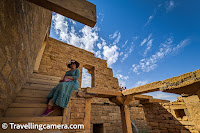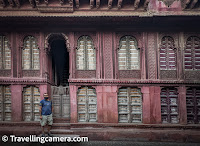Located in the small village of Abhaneri in the Dausa district of Rajasthan, Chand Baori is one of the oldest and most well-preserved stepwells in India. Dating back to the 8th or 9th century, this architectural masterpiece was built during the reign of King Chanda of the Nikita dynasty. With its intricate geometric patterns and maze-like steps, Chand Baori stands as a testament to the ingenuity and craftsmanship of ancient Indian engineering.
The Purpose of Chand Baori
Stepwells, known locally as baoris or baolis, were traditionally used as water reservoirs in the arid regions of Rajasthan. Chand Baori was constructed not only to store water but also to serve as a place for locals to gather and cool off during the scorching summer months. Its design helps to maintain the water's temperature cooler than the surrounding air, providing a refreshing escape from the desert heat.
Architectural Design and Structure
Chand Baori is one of the deepest and largest stepwells in India, plunging nearly 13 stories deep and extending over 100 feet into the ground. It is renowned for its stunning 3,500 narrow steps arranged in a symmetrical pattern across 13 levels. The stepwell's geometric design forms a precise and visually captivating pattern that seems to stretch infinitely, creating a mesmerizing optical illusion.
Key Features of Chand Baori:
Symmetrical Steps: The steps are laid out in a criss-cross pattern, descending into the well in a way that creates a zig-zag effect. This precision in design was essential not only for aesthetics but also for easy access to water during different levels of the dry and rainy seasons.
Pavilions and Galleries: The top portion of Chand Baori includes various pavilions and galleries that were likely used by the royal family and nobles. These areas are adorned with intricate carvings and sculptures depicting scenes from Hindu mythology.
Carvings and Sculptures: The walls of the stepwell are decorated with beautiful carvings of gods and goddesses, particularly Hindu deities like Vishnu, Durga, and various other celestial figures. The detailed stonework showcases the artistic talent of the craftsmen of that era.
Cooling Mechanism: Chand Baori was ingeniously designed to maintain a cooler temperature within the stepwell. Its unique construction ensures that the deeper you go, the cooler the air and the temperature of the water, making it a comfortable refuge during hot summers.
The Legend and Myths of Chand Baori
Local legends suggest that Chand Baori was built overnight by ghosts or spirits due to its elaborate design and the precision of its construction. It is said that the stepwell was constructed so quickly that it appeared to have been completed in a single night, which added to its mystique and the belief that it had a supernatural origin.
Connection with Harshat Mata Temple
Chand Baori is located adjacent to the Harshat Mata Temple, which is dedicated to the Goddess of Joy and Happiness. The stepwell was an integral part of the temple complex, as it was used by the devotees to perform their rituals and ablutions before worshipping the goddess. This connection between the stepwell and the temple highlights the cultural significance of Chand Baori as a place of both practical and spiritual importance.
Restoration and Conservation Efforts
Over the centuries, Chand Baori fell into disrepair due to neglect and the harsh climatic conditions of Rajasthan. However, in recent years, several restoration efforts have been undertaken by the Archaeological Survey of India (ASI) and local heritage conservation groups to preserve this architectural marvel. Their work has helped restore the intricate carvings and maintain the structural integrity of the stepwell, ensuring that future generations can witness its grandeur.
Best Time to Visit Chand Baori
The ideal time to visit Chand Baori is during the winter months (October to March) when the weather in Rajasthan is pleasant and conducive to exploring outdoor sites. Visiting early in the morning or late afternoon is recommended to avoid the heat and to enjoy the serene ambiance of this historical site.
How to Reach Chand Baori
Location: Chand Baori is situated in the village of Abhaneri, about 95 km from Jaipur and around 200 km from Delhi.
By Road: The stepwell is easily accessible by road from Jaipur and Delhi. You can hire a taxi or take a bus to reach Abhaneri.
By Train: The nearest railway station is Bandikui, which is well-connected to Jaipur and other major cities.
By Air: The closest airport is Jaipur International Airport, located about 95 km away from the site.
Why Visit Chand Baori?
Architectural Marvel: Chand Baori’s stunning design and intricate carvings make it a must-see for architecture enthusiasts and history lovers.
Cultural Experience: Its connection to Harshat Mata Temple offers a deeper understanding of the region’s religious and cultural significance.
Photographer’s Delight: The geometric symmetry and the unique play of light and shadows within the stepwell make it a paradise for photographers.
Historical Significance: As one of India’s oldest and deepest stepwells, it offers a fascinating glimpse into ancient water conservation techniques and engineering brilliance.
Chand Baori in Abhaneri is not just a stepwell; it’s a symbol of India’s rich architectural heritage, engineering ingenuity, and spiritual legacy. This iconic structure continues to captivate the imagination of travelers and historians with its timeless beauty and the mysteries that surround its origins. Whether you are a history buff, an architecture enthusiast, or a curious traveler, a visit to Chand Baori will leave you spellbound with its grandeur and historical significance.
Related Blogposts:
 Chand Baori in Abhaneri: A Marvel of Ancient Indian Architecture in Rajasthan
Chand Baori in Abhaneri: A Marvel of Ancient Indian Architecture in Rajasthan
 Bhandarej Baori: An Ancient Stepwell of Rajasthan's Heritage
Bhandarej Baori: An Ancient Stepwell of Rajasthan's Heritage
.jpg) Tour de Churu Streets having grand havelis with marvelous fresco paintings | Haveli Heritage Tour Rajasthan, India
Tour de Churu Streets having grand havelis with marvelous fresco paintings | Haveli Heritage Tour Rajasthan, India
 Beautiful Vyas Chhatris in Jaisalmer, Rajasthan || the most unusual sunset point built in a cremation ground
Beautiful Vyas Chhatris in Jaisalmer, Rajasthan || the most unusual sunset point built in a cremation ground
 Magnificent Cenotaphs at the Bada Bagh, Jaisalmer, Rajasthan || Exorbitant Ticket Prices can be a deterrent to anyone visiting the place
Magnificent Cenotaphs at the Bada Bagh, Jaisalmer, Rajasthan || Exorbitant Ticket Prices can be a deterrent to anyone visiting the place
 An interesting drive from Kuldhara to Khaba Fort, Dedha, Jaisalmer, Rajasthan || The Journey was definitely worth the visit to this beautiful little fort
An interesting drive from Kuldhara to Khaba Fort, Dedha, Jaisalmer, Rajasthan || The Journey was definitely worth the visit to this beautiful little fort
 A half day detour to Sambhar Salt Lake, Rajasthan from NH48 || What makes India's Largest Inland Salt Lake worth visiting in winters?
A half day detour to Sambhar Salt Lake, Rajasthan from NH48 || What makes India's Largest Inland Salt Lake worth visiting in winters?
 A fulfilling stop at Mandore in Jodhpur, Rajasthan || The old seat of the Rathore clan and also the birthplace of Mandodari
A fulfilling stop at Mandore in Jodhpur, Rajasthan || The old seat of the Rathore clan and also the birthplace of Mandodari
 The Golden Fort of Jaisalmer, Rajasthan || A thriving, pulsating mini city within the walls of the fort
The Golden Fort of Jaisalmer, Rajasthan || A thriving, pulsating mini city within the walls of the fort
 The splendid architecture of Patwon ki Haveli in Jaisalmer, Rajasthan || One of the most opulent of the havelis in Jaisalmer
The splendid architecture of Patwon ki Haveli in Jaisalmer, Rajasthan || One of the most opulent of the havelis in Jaisalmer
 The Abandoned Village of Kuldhara near Jaisalmer, Rajasthan || Facts and Fables about why the Paliwal Brahmins abandoned this village of their ancestors
The Abandoned Village of Kuldhara near Jaisalmer, Rajasthan || Facts and Fables about why the Paliwal Brahmins abandoned this village of their ancestors
 The Amazing Pokaran Fort near Jaisalmer, Rajasthan || A beautiful structure that effortlessly blends with the desert landscape it is built in
The Amazing Pokaran Fort near Jaisalmer, Rajasthan || A beautiful structure that effortlessly blends with the desert landscape it is built in
 Vedi Temple inside KumbalGarh Fort, Rajasthan - 3 Storey Octagonal structure standing strong on 36 pillars around world's second largest wall
Vedi Temple inside KumbalGarh Fort, Rajasthan - 3 Storey Octagonal structure standing strong on 36 pillars around world's second largest wall












.jpg)
















.jpg)

.jpg)
Comments